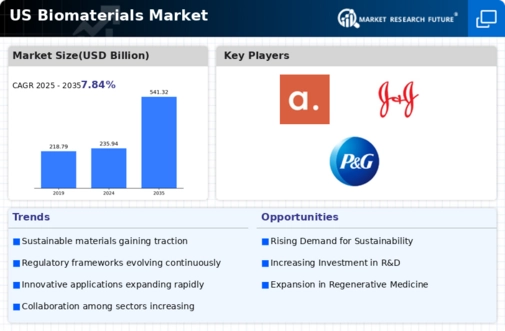Consumer Awareness and Preferences
There is a noticeable shift in consumer awareness regarding the environmental impact of materials used in various products. This heightened awareness is driving demand for biomaterials that are perceived as more sustainable and eco-friendly. As consumers increasingly prefer products made from renewable resources, manufacturers are compelled to adapt their offerings. This trend is expected to influence approximately 30% of purchasing decisions in the biomaterial market by 2025. Consequently, companies that prioritize sustainability in their product development are likely to gain a competitive edge in the biomaterial market.
Investment in Sustainable Practices
Investment in sustainable practices is becoming increasingly critical for companies operating within the biomaterial market. As stakeholders demand greater corporate responsibility, businesses are allocating resources towards sustainable sourcing and production methods. This trend is likely to result in a 25% increase in investments directed towards sustainable biomaterial solutions by 2025. Companies that successfully integrate sustainability into their operations may not only enhance their brand reputation but also capture a larger share of the biomaterial market, as consumers gravitate towards environmentally responsible products.
Regulatory Support for Biomaterials
The biomaterial market in the US benefits from increasing regulatory support aimed at promoting the use of sustainable and biocompatible materials. Government agencies, such as the FDA, are actively developing guidelines that facilitate the approval process for innovative biomaterials. This regulatory framework encourages manufacturers to invest in research and development, potentially leading to a market growth rate of approximately 15% annually. As regulations evolve, they create a conducive environment for the introduction of new products, thereby enhancing the competitive landscape of the biomaterial market.
Technological Innovations in Production
Technological advancements in the production processes of biomaterials are significantly influencing the biomaterial market. Innovations such as 3D printing and biofabrication are enabling the creation of complex structures that were previously unattainable. These technologies not only enhance the functionality of biomaterials but also reduce production costs, making them more accessible to a broader range of applications. By 2025, it is anticipated that these innovations could lead to a reduction in manufacturing costs by up to 20%, thereby stimulating growth in the biomaterial market.
Growing Demand in Healthcare Applications
Healthcare applications are a primary driver for the biomaterial market, as the demand for advanced medical devices and implants continues to rise. The increasing prevalence of chronic diseases and the aging population in the US are contributing to this trend. In 2025, the healthcare sector is projected to account for over 40% of the total biomaterial market revenue, reflecting a robust growth trajectory. Innovations in biomaterials, such as drug delivery systems and tissue engineering, are likely to further propel this demand, making healthcare a pivotal sector for the biomaterial market.

















Leave a Comment